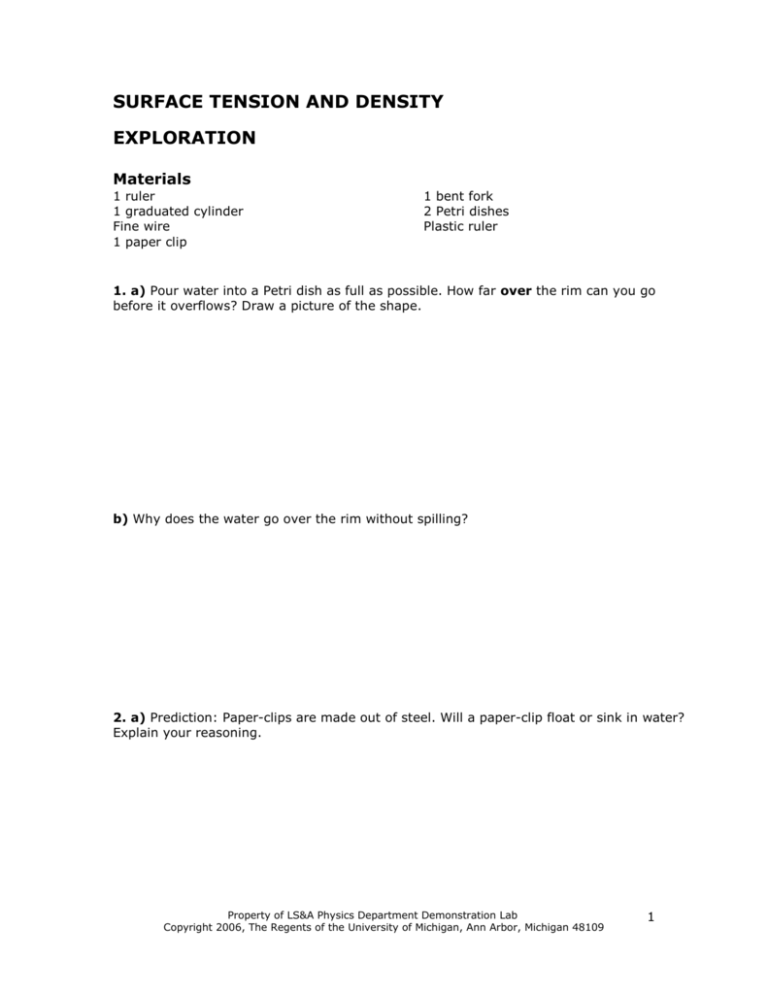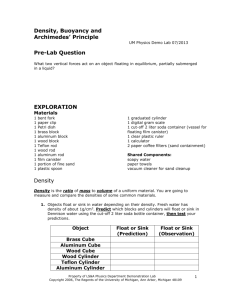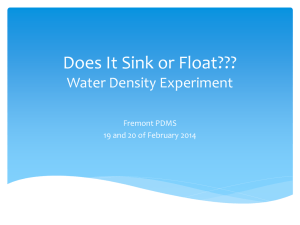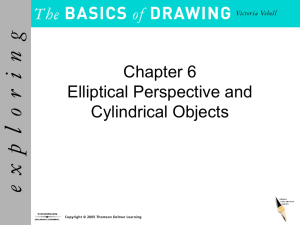Surface Tension and Density - University of Michigan SharePoint
advertisement

SURFACE TENSION AND DENSITY EXPLORATION Materials 1 ruler 1 graduated cylinder Fine wire 1 paper clip 1 bent fork 2 Petri dishes Plastic ruler 1. a) Pour water into a Petri dish as full as possible. How far over the rim can you go before it overflows? Draw a picture of the shape. b) Why does the water go over the rim without spilling? 2. a) Prediction: Paper-clips are made out of steel. Will a paper-clip float or sink in water? Explain your reasoning. Property of LS&A Physics Department Demonstration Lab Copyright 2006, The Regents of the University of Michigan, Ann Arbor, Michigan 48109 1 b) Place a paper-clip in the water by lowering it onto the surface with the bent fork. Does this agree with your prediction? Explain your observations. Sometimes the paper clip will perform better if it is somewhat greasy, consider rubbing it with your fingers or on your forehead or nose. Challenge Work: 1. Float a few paper clips in a Petri dish with tap water and observe the interactions between them. Also observe how they interact with the dish walls. Record your observations and conclusions below. 2. Will the paper clip sink if it is wet before it is placed in the Petri dish? Explain your prediction, test with a wet paper clip, and then compare your findings with your prediction. Everyday Applications The most famous use of a density measurement was done by Archimedes (290210 B.C.). He was hired by the king to verify that a gold crown he’d commissioned had not been substituted in part by less valuable (and less dense) silver. However, the crown was very expensive and Archimedes could not melt the crown to ascertain its volume. While stepping into a bath he observed the change in water level, and realized he could do a volume displacement measurement. In his excitement, he ran through the streets yelling “Eureka! Eureka!” Product manufacturers (in industries such a food, beauty, and health) use density measurements to verify consistency among products. They measure the density of product from different batches to make sure that there is consistency. Property of LS&A Physics Department Demonstration Lab Copyright 2006, The Regents of the University of Michigan, Ann Arbor, Michigan 48109 2 APPLICATION Materials 1 graduated cylinder Fine wire 2 Petri dishes Plastic ruler 1 calculator 3 blocks (1 each: brass, aluminum, wood) 2 cylinders (1 each: wood, teflon) 1 scale 1 ruler Soapy Water 1. Create a floating wire water bug. Explore the success and failure of different types of models to float on the water. We suggest making two so that there are more prototypes to experiment with in the group. Make a drawing of a successful water bug. Discuss with your group which parameters make the water bug float or sink and record. 2. While floating a successful water bug, add a drop of soap with your finger onto the surface of the pure water. Place the drop on the far side of the Petri dish from the bug. Observe what happens. Discuss with your group what you’ve observed and record your conclusions about what happened. Property of LS&A Physics Department Demonstration Lab Copyright 2006, The Regents of the University of Michigan, Ann Arbor, Michigan 48109 3 3. Properties of Matter The periodic table organizes elements by the number of protons in each atom, and that is a precise way of identifying atoms. However, we live in the large scale world and counting the number of protons in atoms is not an easy way to identify something. Most materials are a complex combination of different elements, and the efficient and commonly used method for identifying unknown materials is by observing color, texture, and density. Density is the ratio of mass to volume of a uniform material. You are going to calculate the density of some common materials and compare the densities. Objects float or sink in water depending on their relative density to water. Fresh water has density of about 1g/cm3. Predict which blocks and cylinders will float or sink in Dennison water, then test your predictions. Float or Sink (Prediction) Float or Sink (Observation) Brass Cube Aluminum Cube Wood Cube Wood Cylinder Teflon Cylinder Explain your predictions and observations. 4a. Measure the dimensions of the blocks using your ruler (use cm): Brass Aluminum Wood Length (l) Width (w) Height (h) 4b. Measure the dimensions of the cylinders (use cm): Wood Teflon Height (h) Diameter (d) Property of LS&A Physics Department Demonstration Lab Copyright 2006, The Regents of the University of Michigan, Ann Arbor, Michigan 48109 4 5. Measure the mass (weight) of the blocks and cylinders in g with the scales. Calculate the volume of the blocks and the cylinders. The volume of a block is: V h l w The volume of a cylinder is the area of the base times the height: 1 V (diameter ) 2 l 4 Density (d) is defined as the ratio of mass (m) to volume (v): d m V Calculate the density of each block and cylinder from your mass and volume findings. Mass (in grams) Volume (in cm3) Density (in g/ cm3) Brass Cube Aluminum Cube Wood Cube Wood Cylinder Teflon Cylinder Challenge Work: 1. Which is denser: a 10 lb. bag of feathers or a 10 lb. bag of lead? 2. Calculate the density of water in Dennison. Use the graduated cylinder. First measure the cylinder alone, then measure the cylinder with some amount of water in it (preferably at an evenly round number e.g. 10mL). Subtract the mass of the cylinder from the cylinder with water in it to find the mass of the water. Milliliters are a unit of volume, 1 mL = 1 cubic centimeter. Calculate the density of Dennison water. Property of LS&A Physics Department Demonstration Lab Copyright 2006, The Regents of the University of Michigan, Ann Arbor, Michigan 48109 5 4. Some redwood trees on the coast of Northern California grow to a height of 122 m (367 ft) and a diameter of 7 m (22 ft). If one of these massive trees fell into the water, would it float or sink? Summary Final Clean-up Please clean all table surfaces you used and return equipment to the carts. Please dry individual pieces that may be wet and dispose of water in the sink. Bibliography and recommendations for further reading: Wikipedia contributors, "Density," Wikipedia, The Free Encyclopedia, http://en.wikipedia.org/w/index.php?title=Density&oldid=53475076 (accessed May 18, 2006). National Park Service, “About the Trees,” NPS http://www.nps.gov/redw/trees.html (accessed May 18, 2006). Property of LS&A Physics Department Demonstration Lab Copyright 2006, The Regents of the University of Michigan, Ann Arbor, Michigan 48109 6









